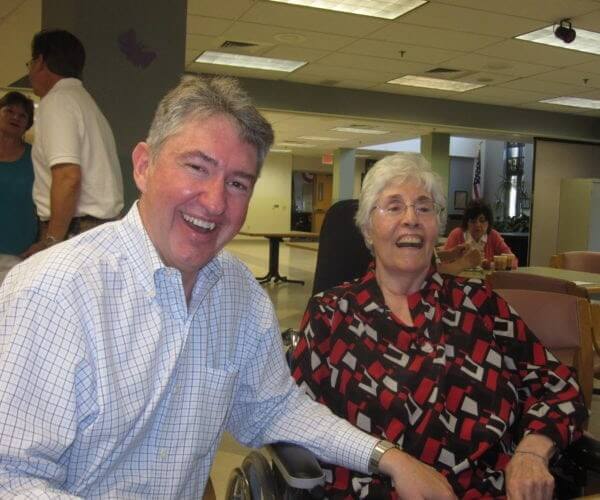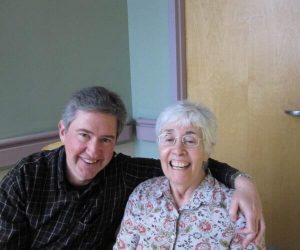
When Kevin Jameson founded the Dementia Society of America he was on a journey of profound change with his wife, Ginny. For several years, Ginny had been living with dementia. As husband and caregiver, Kevin had become well-educated on the disease. Based on his experience with Ginny, he saw a need to create an organization to serve as a resource for individuals seeking guidance and support.
In Part 1 of this 2-part post, Kevin talks about his life with Ginny following her diagnosis. You can also listen to the full interview below.
THE DIAGNOSIS
For us, we went through a trajectory which I think is common. I hear it a lot with married couples. In the beginning, whether it’s the man or the woman that might have something going on, it’s never originally thought of as being some type of long-term cognitive decline. Dementia manifests itself in other ways.
Courtesy of Kevin Jameson
For Ginny, it manifested itself in behavior, attitude, and personality. There became an edge to her. She was always a very kind woman, but also had a bit “hot-blooded” Italian in her and it became amplified in a way that wasn’t like her normal self. We started out by going to marriage counseling. I drove it because I knew there was something wrong. That went on for probably six months to a year before the therapist said to us “there’s something more going on here and Ginny needs to see somebody in addition to coming to see me.”
So we started seeing a psychiatrist who prescribed some meds but really couldn’t understand it either. Then it became evident one night when we were out to dinner. We had been to this restaurant about a month prior and I met the hostess. When we went the second time, I said “hello” to the hostess by name. My wife asked “how do you know her” and I said “well, we were here about a month ago remember asking for her name” and she goes “Well I’ve never been here before you must’ve been here with another woman.” So a lot of alarm bells went off for me.
It took about a year to go from the general practitioner to a neurologist and a very competent team at a nearby university. The actual diagnosis which took another year after that, as they needed to test her abilities to get a baseline for future comparative tests. So we’re talking a span of three to four years before we really knew what was going on. Ginny was told “you have a progressive form of dementia.” After we left, she turned to me and said “OK, well, where are we going to lunch?” That appointment was the last time she really said, or discussed, anything more about it. I figured that she had decided to move forward with life and I was okay with that.
MOVING FORWARD
We always traveled extensively so within a week’s time [of the diagnosis], I made plans and we went to China. Then after that we went to India. And after that we went to Egypt. Then we went to Ireland. I just made the decision that for as long as she was physically able we were going to go to wonderful places and see wonderful things. We were going to be social and get out with other people. That’s what we decided to do and we did it.
Courtesy of Kevin Jameson
When Ginny and I got married in 1985, she had two children. At that point, I had not been married and had no children of my own. They [her children] were phenomenal. They loved and supported the fact that we were going to do everything and go everywhere, and we did, to the best of our abilities.
MAKING DECISIONS
I continued to work up until Ginny’s last year of life. We started out in the mid-2000s with a caregiver agency coming in twice a week at night to help Ginny make a meal. And then it became every night that I was away and then they would stay overnight. Then I hired somebody that actually lived in our house. I re-fitted the house to create an apartment for the caregiver who lived there for about a year and a half.
The problem became that Ginny was still not safe even though we had somebody in the house. One night Ginny was going upstairs and fell backwards. She dislocated her fingers. I was ten feet away from her when it happened. But she couldn’t express her pain even though I knew she was in pain. I put her fingers back in place, took her to the hospital emergency room. Then I made the decision right there that no matter how much I loved having her at home, and would hope she would’ve been able to stay, she needed to move to a place with even greater supervision.
Ginny was still young enough in her sixty’s and, quite frankly, was in perfect physical health. It really became more about what was safest for her and all parties concerned. When I was with her at home alone, one of my concerns was that I would have a heart attack or fall off a ladder and she wouldn’t know what to do. Ginny probably would have just sat or stood there. She could no longer make a phone call. She couldn’t complete intelligible sentences. And there was quite a bit of anxiety being “locked” in the house all day. So no matter how much we got her out and about, she became at risk for bolting out the door. There was a lot of anxiety for her, and me, and the other caregivers.
LIVING IN COMMUNITY
Once I got her into the memory care community she went to, there was a weight lifted off her shoulders. Although she had some initial anxiety about being there, it evaporated quickly. She was a very social person and so she immediately took up walking with a group of women and talking with anybody there and they loved her. It was wonderful. In the end it was – as you can imagine tough to leave her because she’d want to come with me – but, she really didn’t verbalize, and I’m not sure understood that I was her husband anymore, and even though I could tell she loved me, and I lover her, it became easier for both of us.
The one thing that I always, always did, even in the early stages of her condition, I always spoke positively with her about everything. I knew that there was no need to argue with her about anything once the diagnosis had been made. That wasn’t going to get me anywhere and it was only going to frustrate her, so I immediately took the position that everything was wonderful and everything was beautiful. I smiled at every chance I could with her. She reflected it back and was happy. What else could I ask for.
I did light therapy [with her]. I got a light machine that supplemented vitamin D. But I would also get her outside as often as I could. She was ultimately in a wheelchair after a couple of years so we’d spin around the parking lot, and we’d sit outside for an hour or two. I have videos of her in the great outdoors where she would just smile and put her face to the wind.
After 32 years of marriage to Kevin, Ginny passed away in 2014. Kevin founded the Dementia Society of America to honor Ginny’s life. DSA exists to enhance the quality of life for those living with Dementia, caregivers, and the community.
In Part 2, Kevin talks about the work of the Dementia Society of America.
Dementia Society of America is a resource partner with Music & Memory. Blakeford at Green Hills is a certified Music & Memory community.



